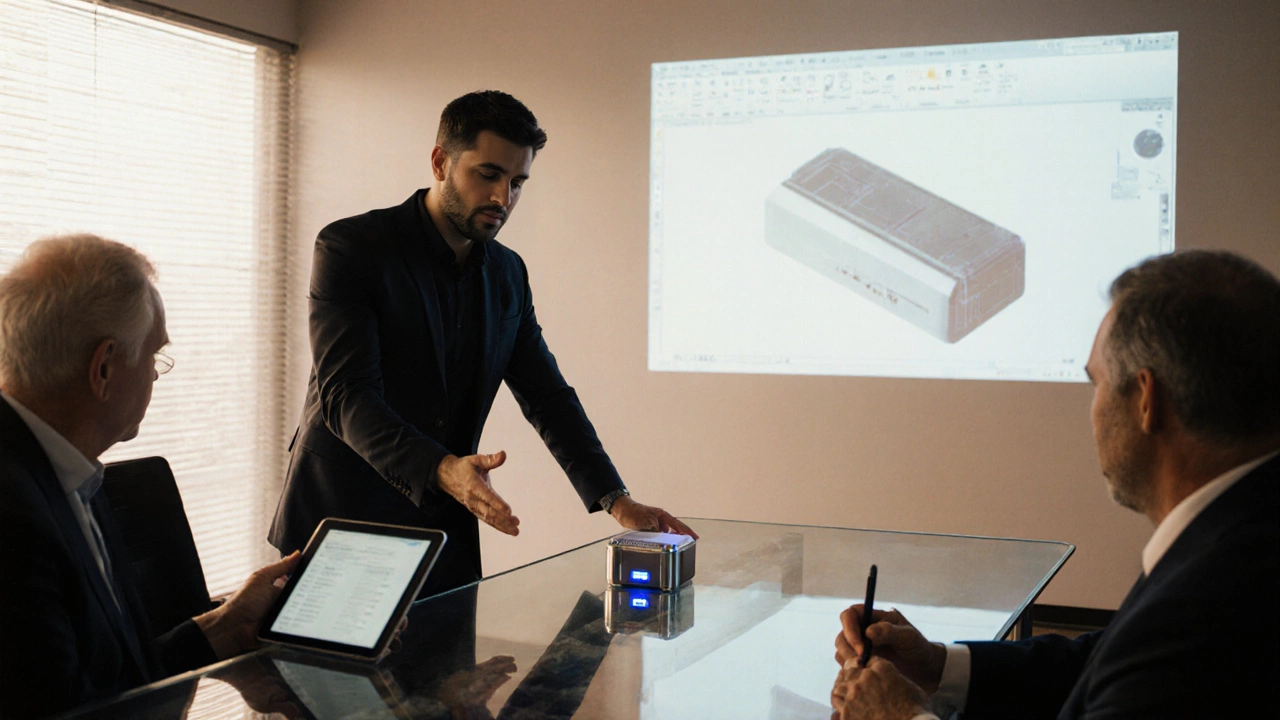Manufacturer Pitch Cost Calculator
Calculate Your Production Costs
Estimate your manufacturing viability based on key factors manufacturers care about: volume, margins, and lead-time.
Manufacturers prefer higher volumes for better margins
Cost of all individual parts in your Bill of Materials
Initial investment to create molds or production lines
Your target price in the market
Production Analysis
When you have a fresh product concept, Pitch to Manufacturer a structured presentation that convinces a manufacturing partner to produce your product idea is the bridge between an invention and a real‑world product. Without a solid pitch, even the most brilliant design can stall in a drawer. This guide walks you through everything you need - from the paperwork you should have ready to the storytelling tricks that keep a manufacturer’s attention.
Know What the Manufacturer Really Wants
Manufacturers aren’t just looking for a cool gadget; they need evidence that the project will be profitable, scalable, and low‑risk. Think of them as investors who care about three numbers: volume, margin, and lead‑time. If you can show a clear pathway from prototype to production‑run, you instantly become a more attractive partner.
Gather Your Core Materials
- Prototype a functional model that demonstrates core features and manufacturability. Whether it’s a 3D‑printed shell or a hand‑wired circuit board, the prototype should highlight the parts that matter most to the factory.
- Non‑Disclosure Agreement (NDA) a legal document that protects your idea while you discuss details with a manufacturer. Have a short, clear NDA ready to sign before you reveal any proprietary specs.
- Bill of Materials (BOM) a detailed list of every component, quantity, and cost needed to build the product. The BOM shows the manufacturer how complex the supply chain will be.
- Cost Estimate a rough calculation of per‑unit production cost, tooling fees, and tooling amortization. Even a ballpark figure demonstrates you’ve done the math.
- Market Research data on target customers, price points, and competitive landscape. Manufacturers want to see that demand exists beyond your personal network.
- Value Proposition a concise statement of why the product solves a problem better than anything else. This becomes the headline of your pitch.
Craft a Compelling Narrative
Facts are crucial, but stories sell. Start with the problem your product solves, then walk the manufacturer through how your solution works, and finish with the market upside. Keep each section under three minutes if you’re presenting in person - attention spans are short.
Use visual aids: a one‑page slide that merges the BOM, cost estimate, and projected profit margin helps a factory engineer see the numbers at a glance. If you’re pitching remotely, send a PDF beforehand and reference it during the call.
Choose the Right Pitch Format
Not every manufacturer prefers the same medium. Below is a quick comparison to help you decide.
| Format | Pros | Cons |
|---|---|---|
| In‑person meeting | Immediate feedback, builds trust | Travel cost, scheduling hurdles |
| Virtual video call | Low cost, easy to record | Potential technical glitches, harder to read body language |
| Written deck (PDF) | Referenceable, can be shared widely | Lacks real‑time interaction, may be ignored |

Deliver the Pitch with Confidence
Start with a brief introduction of yourself and any relevant experience - credibility matters. Then present the pitch to manufacturer in three parts: problem, solution, and business case. Allow pauses for questions; a manufacturer will often interject with concerns about material sourcing or tooling time.
End with a clear ask: Do you want a detailed quotation? A pilot run? Or an invitation to visit your prototype? A specific next step prevents the meeting from ending in vague goodwill.
Handle Objections Like a Pro
Common push‑backs include “tooling too expensive”, “volume too low”, or “design not optimized for mass production”. For each, have a prepared response:
- Tooling cost: Show a phased rollout plan where the first 1,000 units fund the tooling, then scale up.
- Low volume: Highlight pre‑orders, crowdfunding results, or contracts with distributors.
- Design tweaks: Bring a CAD file that demonstrates how minor changes can reduce material waste by 15%.
Remember, objections are opportunities to prove you’ve thought ahead.
Follow‑Up and Negotiate
After the meeting, send a thank‑you email that recaps the key points, attaches the updated BOM, and reiterates the next steps. If the manufacturer sent a quotation, compare it against your cost estimate and negotiate on tooling fees or lead‑time. Bringing a third‑party costing tool (like a cost‑to‑manufacture calculator) can give you leverage.

Quick Checklist Before You Walk In
- Signed NDA on both sides.
- Functional prototype ready for inspection.
- Accurate BOM and cost estimate.
- One‑page value proposition slide.
- Market research summary with demand proof.
- Clear ask and timeline.
Cross‑checking this list reduces the chance of being caught off‑guard.
Common Pitfalls and How to Avoid Them
- Over‑promising on price: Keep unit cost numbers realistic; manufacturers will call you out if they see a wide gap.
- Skipping the NDA: Without legal protection, ideas can be copied before you secure a deal.
- Ignoring scale‑up challenges: Talk about how the design will hold up at 10,000+ units, not just a prototype batch.
- Bad timing: Align your pitch with the manufacturer’s production schedule - avoid peak seasons unless you have a solid reason.
Putting It All Together - A Sample Pitch Outline
- Introduction - who you are, relevant background.
- Problem statement - the pain point you’re solving.
- Solution demo - show the prototype, highlight key features.
- Market validation - present research, pre‑orders, or pilot studies.
- Financial overview - BOM, cost estimate, projected margin.
- Manufacturing ask - tooling plan, first‑run volume, timeline.
- Q&A - invite the manufacturer to raise concerns.
- Next steps - schedule follow‑up, share detailed CAD files, set a date for a quotation.
Follow this flow, adapt it to the specific manufacturer’s culture, and you’ll turn a cold meeting into a partnership conversation.
Do I need a physical prototype for the first pitch?
A functional prototype isn’t mandatory, but it dramatically raises credibility. If you can’t build one, high‑fidelity renders and a clear engineering drawing can suffice for an initial conversation.
How detailed should my Bill of Materials be?
Include every component, part number, supplier, and estimated unit cost. Even if some items are placeholders, it shows you’ve mapped the supply chain.
What’s the best way to protect my idea before signing an NDA?
File a provisional patent or design registration if the concept is truly novel. This gives you legal backing while you negotiate terms.
Should I discuss pricing expectations early?
Bring a cost estimate but avoid locking in a final price until the manufacturer reviews your BOM and tooling requirements. Treat it as a starting point for negotiation.
How do I handle a manufacturer who says my design isn’t “factory‑ready”?
Ask for specific feedback - material choices, tolerances, assembly steps. Use that input to revise CAD files and show the updated design in the next meeting.
